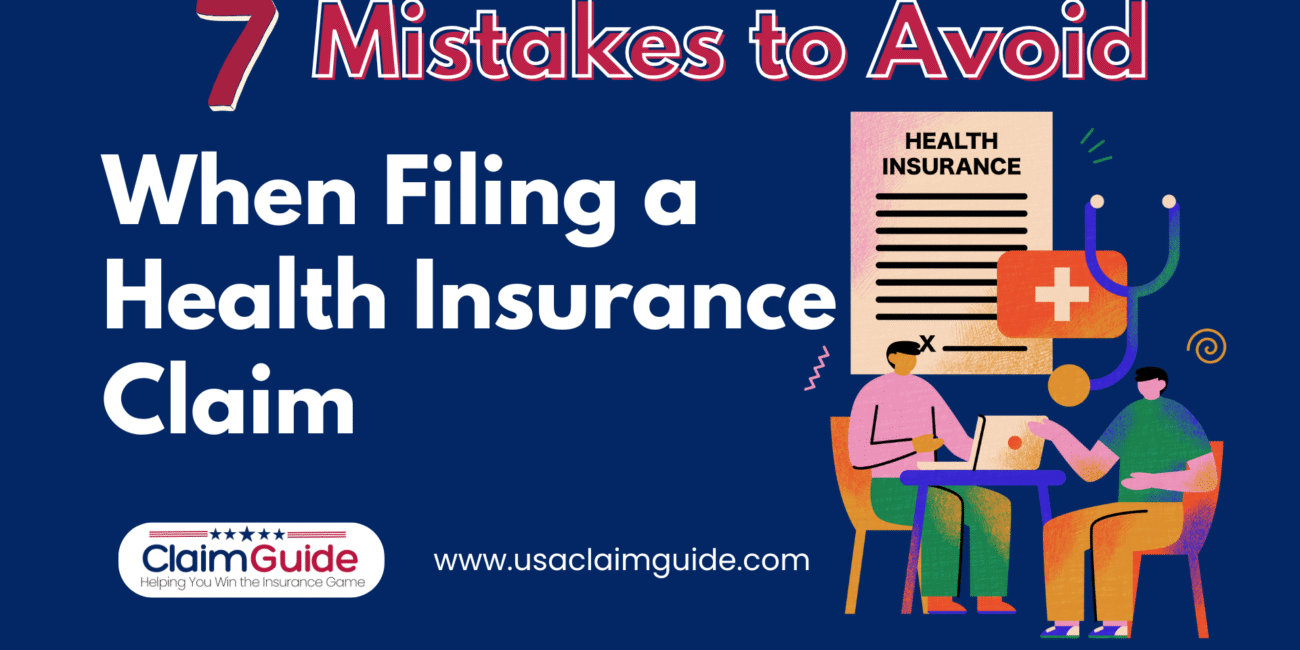Filing a health insurance claim in the U.S. may seem like a routine task, but it’s actually one of the most important steps in managing your medical expenses wisely. As healthcare costs continue to rise across the country, more Americans are actively searching for ways to submit a health insurance claim without errors, avoid health insurance claim denials, and understand the step-by-step claim process in the U.S. healthcare system.
Every year, thousands of Americans experience health insurance claim rejections not due to lack of coverage, but because of simple filing errors, misunderstandings, or missed deadlines. Whether you’re navigating your first claim or dealing with a high-cost procedure, knowing what to expect and how to avoid mistakes can help you stay in control of your healthcare costs and get the benefits you’re entitled to.
In today’s often costly healthcare system, understanding how to properly file a health insurance claim in the U.S. has never been more important. As medical expenses continue to rise and insurance policies grow more intricate, even a small misstep in the claims process can lead to delays, denials, or out-of-pocket surprises that strain your finances and cause unnecessary stress.
Whether you’re dealing with an emergency room visit, surgery, or ongoing treatment, your ability to get reimbursed or have your insurer pay directly relies heavily on how accurately and timely you file your claim. Unfortunately, many people face delays, rejections, or reduced payouts simply because they overlook minor details or misunderstand their coverage terms.
If you’ve ever asked:
- “How do I file a health insurance claim correctly in the U.S.?”
- “Why was my health insurance claim denied?”
- “What documents are needed for a health insurance reimbursement?”
…then this guide is for you.
This article covers the essential do’s and don’t of the claims process, helping you navigate it like a pro whether you’re using employer-sponsored insurance, private health coverage, or an ACA plan. We’ll walk through the critical elements of avoiding common health insurance claim mistakes, interpreting your explanation of benefits (EOB), and choosing the right insurer that simplifies the process instead of complicating it.
Remember, a single error in your claim submission like using an out-of-network provider, missing documentation, or skipping per-authorization can mean the difference between getting your medical costs covered and having to pay out of pocket.
Navigating the complexities of health insurance can be challenging especially when it comes to filing a claim. Whether you’re handling a routine doctor’s visit or an unexpected medical emergency, avoiding common errors in your health insurance claim in the U.S. can make the difference between a smooth reimbursement and a costly denial.
In this guide, we’ll explore everything you need to know: how health insurance claims work, what policies are best, how long claims typically take, necessary documents, and most importantly the top 7 mistakes to avoid when filing a claim.
Understanding How a Health Insurance Claim Policy Works
A health insurance claim is a formal request sent by you or your healthcare provider to your insurance company, asking for reimbursement or direct payment for medical services received.
There are two types of claims:
- Cashless Claims: Processed directly between your healthcare provider and insurer if the provider is in-network.
- Reimbursement Claims: You pay upfront, then file for reimbursement.
Key Players in the Claim Process:
- Policyholder: The person insured.
- Provider: Doctor or hospital delivering the service.
- Insurer: The insurance company reviewing and paying the claim.
How It Works:
- You receive medical treatment.
- The provider or you submit a claim.
- The insurer reviews the claim to verify:
- Coverage eligibility
- Medical necessity
- Proper documentation
- Insurer pays the provider directly or reimburses you.
What Health Insurance Claim Policy Is Best?
The “best health insurance policy” depends on individual needs, but consider the following:
| Criteria | What to Look For |
|---|---|
| Coverage | Wide coverage across hospitals, procedures, specialists. |
| Network Size | Large provider networks reduce out-of-pocket expenses. |
| Claim Settlement Ratio | Higher is better indicates successful payouts. |
| Customer Support | Efficient assistance simplifies claim issues. |
| Reputation & Reviews | Look at real user experiences and complaints. |
Top Tip:
Always choose a plan that balances premiums, deductible limits, and out-of-pocket maximums.

How Long Does a Health Insurance Claim Take?
The time for a health insurance claim in the U.S. to process varies:
- Cashless Claims: Usually processed within 7–14 business days.
- Reimbursement Claims: May take 15–30 days, depending on the insurer and completeness of documentation.
Claims might be delayed if documents are missing, codes are incorrect, or medical necessity is disputed.
Documents Needed to Claim Health Insurance in the USA
To ensure timely claim processing, gather the following documents:
- Completed Claim Form
- Itemized Bill (from healthcare provider)
- Explanation of Benefits (EOB) – Provided by insurer
- Prescription Records
- Doctor’s Report / Diagnosis
- Payment Receipts
- Insurance Card Copy
- Photo ID
Pro Tip: Always scan and keep digital copies of all documents in case you need to resubmit.
Why Health Insurance Claim Mistakes Cost You More Than You Think
Mistakes in health insurance claims don’t just delay payments they can leave you footing the bill for medical services you assumed were covered. The frustrating part? Most of these errors are avoidable. In fact, a large percentage of denied claims in the U.S. happen because of issues that could have been prevented with just a bit more attention or knowledge upfront.
Whether you’re recovering from surgery, dealing with chronic illness, or simply managing a routine checkup, the last thing you need is a surprise rejection from your insurance company. Unfortunately, even the most organized individuals can fall into common traps like submitting incomplete paperwork, misreading policy limitations, or waiting too long to file a claim.
Understanding how the system works and where it often breaks down is critical. For instance, a misunderstanding about your provider’s network status or failing to obtain per-authorization for a procedure can trigger a denial, leaving you scrambling for answers. Worse, by the time you realize there’s a problem, the appeals deadline may have passed.
This isn’t just a paperwork issue it’s a financial one. Health insurance claim errors can translate into hundreds or even thousands of dollars in unpaid medical bills, credit damage from collections, or gaps in your medical history that impact future coverage.
Learning what not to do when filing a health insurance claim in the U.S. is just as important as knowing how to do it right. When you’re informed about the most common missteps and how to avoid them you protect more than just your money. You gain peace of mind, ensure timely care, and build a better relationship with both your healthcare provider and insurer.
In the following sections, we’ll highlight specific mistakes that real people make every day and explain how you can sidestep them. By taking a proactive, detail-oriented approach to your claims, you’re not just playing defense you’re taking control of your healthcare journey.
Top 7 Mistakes to Avoid When Filing a Health Insurance Claim
Filing a claim isn’t just about submitting a form it requires attention to detail. Below are the biggest pitfalls to avoid:
Missing the Claim Deadline
Each policy has a set time-frame (typically 30-90 days) within which you must file a claim. Missing it can result in outright denial.
Example: John underwent surgery on Jan 1 but submitted his claim on April 15. His insurer denied it due to a missed deadline.
Tip: Mark claim deadlines on your calendar and submit ASAP.
Submitting Incomplete or Incorrect Documents
Submitting a claim without required documents or with wrong codes delays or denies processing.
Common Errors:
- Missing EOB
- Incorrect CPT or ICD-10 medical codes
- Unclear diagnosis or lack of itemized bills
Tip: Double-check codes and documents before submitting. Use insurer’s checklist if available.
Using Out-of-Network Providers
Your claim may be partially or fully denied if your provider is not in the insurer’s network.
Example: Sarah visited a chiropractor not in-network. She had to pay $500 out of pocket as her plan didn’t cover out-of-network services.
Tip: Always confirm provider network status before booking an appointment.
Failing to Pre-Authorize Treatments
Certain procedures require pre-authorization from the insurer. If skipped, claims might be rejected.
Example: An MRI scan without pre-approval may lead to a denied claim.
Tip: Call your insurance company or check your plan’s online portal before scheduling services.
Misunderstanding Policy Terms
Misinterpreting coverage terms like deductibles, co-pays, or exclusions can lead to unrealistic expectations and disputes.
Tip: Read your policy’s Summary of Benefits and Coverage (SBC). If in doubt, ask your insurer directly.
Not Following Up on Pending Claims
Some people file claims and never check the status, missing important updates or requests for additional info.
Tip: Set reminders to check your claim status every 5–7 days. Use your insurer’s mobile app or customer portal.
Ignoring Denial Letters
A claim denial isn’t the end. Many can be reversed upon appeal.
Tip: Always appeal if you believe the denial is incorrect. Include supporting medical records and a detailed explanation.
Resource: Learn how to file an appeal through HealthCare.gov
Also Read: What Is an Explanation of Benefits (EOB) and Why It Matters for Your Health Insurance

What to Do When Your Health Insurance Claim Is Denied
Few things are more frustrating than receiving a letter that says your health insurance claim has been denied especially after you’ve already received the care. You’ve followed all the steps, submitted the paperwork, and trusted your insurance provider to do their part. But now, you’re left with more questions than answers and a bill that wasn’t supposed to land in your lap.
Claim denials can happen for a variety of reasons some legitimate, others the result of errors, miscommunication, or policy fine print most people don’t even know exists. And while it might feel like a dead end, the truth is, a denial doesn’t always mean you’re out of options. In fact, knowing what to do after a health insurance claim denial can often turn the situation around in your favor.
Navigating a denied claim is about more than just filing an appeal. It requires a clear understanding of why the denial occurred, how to request a detailed explanation, and what steps to take to challenge the decision. From misapplied billing codes to missing prior authorization, the reasons can be as technical as they are avoidable.
In many cases, denied claims can be successfully overturned but only if you act quickly and strategically. Insurance companies are required by law to provide specific reasons for their decisions and to allow policyholders the right to appeal. Still, many Americans never pursue this right because the process feels overwhelming or unclear.
That’s why it’s so important to approach a denial with a plan. Whether you’re filing a first-level appeal, asking for a peer review, or preparing supporting medical documentation, each move should be informed and intentional.
Here’s exactly what to do, step by step:
- Review the Denial Letter Carefully
- Contact Your Insurer for Clarification
- Gather Supporting Documentation
- Submit a Formal Appeal
- Escalate to State Insurance Department (if needed)
Pro Tip: Keep a written record of all communication with your insurer.
Sample Appeal Letter for Denied Health Insurance Claim
Here’s a professionally written sample you can adapt based on your specific situation:
[Your Name]
[Your Address]
[City, State ZIP Code]
[Phone Number]
[Email Address]
[Date]
To:
[Insurance Company Name]
Attn: Appeals Department
[Address of Insurance Company]
Subject: Appeal for Denied Health Insurance Claim
Policy Number: [Your Policy Number]
Claim Number: [Claim Number]
Date of Service: [Date of Medical Service]
Dear Appeals Representative,
I am writing to formally appeal the denial of coverage for medical services provided to me on [Date of Service] by [Provider’s Name]. According to the Explanation of Benefits (EOB) I received, the claim was denied on the basis of “[insert stated reason for denial, e.g., not medically necessary].”
I respectfully disagree with this decision. The treatment I received was not elective—it was essential to diagnose and manage [specific condition, e.g., chronic back pain]. My physician, Dr. [Doctor’s Name], recommended this course of action based on clinical evaluations and diagnostic findings (see attached medical records and referral).
Attached to this letter are the following:
A letter of medical necessity from Dr. [Doctor’s Name]
Copies of relevant lab results and imaging
A copy of the EOB indicating the denial
The original per-authorization approval (if applicable)
I request that you reconsider the denial and process this claim for payment. If further information is needed, I am happy to provide it. Please confirm receipt of this appeal and notify me of the decision once reviewed.
Thank you for your time and prompt attention to this matter.
Sincerely,
[Your Name]
[Signature, if mailing a hard copy]
Comparison Between Top 5 Health Insurance Providers in the U.S.
Here’s how major insurers stack up based on network, claim service, and affordability:
| Provider | Network Size | Claim Processing | Monthly Premium (Avg.) | Strength |
|---|---|---|---|---|
| UnitedHealthcare | Very Large | Fast, efficient | $450 | Largest network |
| Blue Cross Blue Shield (BCBS) | Extensive | Reliable | $430 | Wide coverage |
| Aetna | Large | Good support | $410 | Preventive care |
| Cigna | Mid-to-large | Quick approval | $400 | Wellness incentives |
| Kaiser Permanente | Regional | Efficient | $380 | Integrated care |
Tip: Compare using tools like Healthcare.gov’s plan finder.
Bonus Tips for Filing a Successful Health Insurance Claim in the U.S.
- Use Your Insurer’s Mobile App: Streamlines claims, status tracking, and document uploads.
- Know Your Deductible: Don’t expect full reimbursement unless you’ve met it.
- Keep a Claim Journal: Track dates, payments, provider info, and claim reference numbers.
- Stay Organized: Label documents and save emails/letters.
Also Read: Biggest Mistakes to Avoid When Filing a Life Insurance Claim
Conclusion
Filing a health insurance claim in the U.S. doesn’t have to be stressful. By understanding how policies work, staying organized, and avoiding common mistakes, you can dramatically improve your chances of a successful claim.
Educate yourself, review your plan’s fine print, and always advocate for your rights. Your health and finances depend on it.
If your claim is denied or delayed, don’t panic appeals exist for a reason. Always fight back when justified, and seek support through your state’s Department of Insurance or a health advocate if needed.











